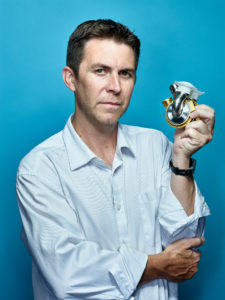
BiVACOR researchers in the Precinct will focus on a next-generation external device controller as part of their development of a world-first Total Artificial Heart (TAH), supported by a $750k grant from the Australian Government through its Medical Research Future Fund (MRFF) and Targeted Translation Research Accelerator (TTRA) program.
As the company heads towards first-in-human clinical trials within the next two years, the grant, matched by in-kind support bringing approximately AUD$2.2 million in funding towards BiVACOR’s clinical advancement, will help develop a lighter, smaller, more portable external controller to give patients better quality of life at home.
External heart controller development to improve patient comfort
BiVACOR’s novel TAH technology is the first long-term therapy dedicated to patients with severe biventricular heart failure.
The implantable total artificial heart, the size of a human fist, is based on a rotary blood pump and uses magnetic levitation (MAGLEV) technology to enable the double-sided centrifugal impeller to rotate in free-space, minimising blood trauma and eliminating mechanical wear.

A long labour of love for founder and Chief Technology Officer (CTO) Dr Daniel Timms, the BiVACOR TAH has enjoyed significant Australian government support over its two decades of R&D.
“Heart failure hits close to home for me. It remains a leading cause of death worldwide, and its prevalence is only increasing,” says Dr Timms, who lost his father to the disease.
“BiVACOR is an Australian-born innovation, and we are extremely grateful for the ongoing support from the Australian government and community.
Without their support, we wouldn’t be where we are today, and this grant gives us a boost in the clinic to drill down into the TAH external controller.”
The TTRA program, a MRFF initiative delivered by MTPConnect, supports new approaches to improve the prevention, dianosis, treatment and management of diabetes and cardiovascular disease complications.

While the implantable device is largely being developed in the US, including through collaboration with the Texas Heart Institute, the latest version heading towards clinical trials has been extensively tested at Griffith University’s Mechanobiology lab, with the aim of understanding and reducing its impact on blood cells.
Across the road at Cohort, where BiVACOR bases its international office, research engineers are focused on the heart’s external controller and its software.
“We want a controller that is as small, lightweight and as ergonomic as possible to maximise portability and comfort,” explains Dr Timms.
“At the same time, it needs to be totally reliable, including its batteries and power system, and we want to create a software interface that enables patients to easily monitor and manage their cardiovascular health, while providing timely and reliable data and alerts to their clinicians when needed.”
During the planned first-in-human trials, patients implanted with the TAH will remain in hospital for monitoring, whilst waiting for a human heart transplant.
“Our goal is to provide the best possible solution for patients facing end-stage heart failure who have run out of options,” says BiVACOR CEO Dr Thomas Vassiliades.
“These funds will give us a clinical advantage as we push on perfecting the external controller for the TAH.”
The BiVACOR TAH builds on the successful transition of Left Ventricular Assist Device (LVAD) technology from volume displacement to durable rotary blood pumps and aims to be the next-generation TAH that sufficiently restores quality of life to patients suffering from severe biventricular heart failure.
The TAH therapy may be initially utilised as a short-term device in a patient awaiting a heart transplant or as a long-term alternative to heart transplantation.
To date, BiVACOR has raised more than AUD$50 million in funding.